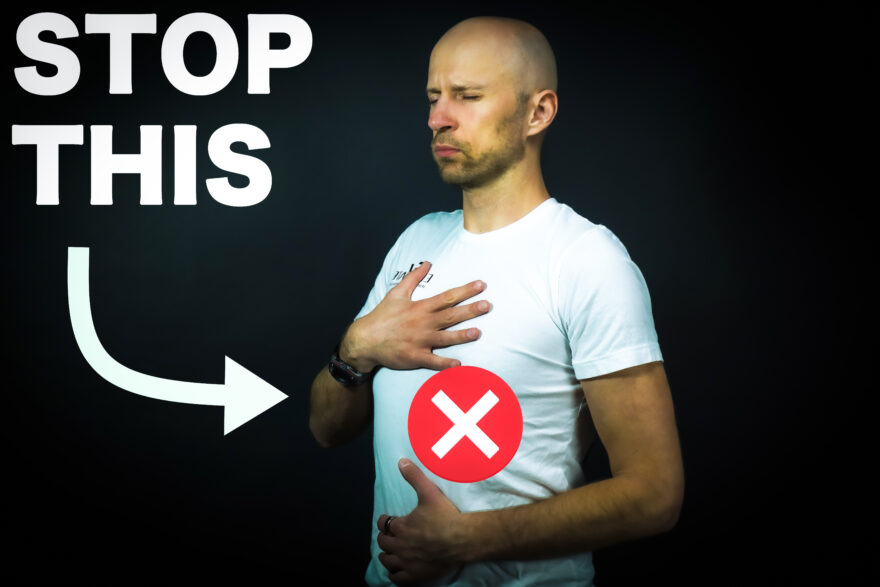Table of Contents
You’ll RUIN all the benefits
Breathing exercises can reduce stress and anxiety, but their effect sizes are small. Nor have they been able to improve sleep apnea.
But that’s likely because most people coach breathing the WRONG way.
In this post, I’ll teach you what that way is and how to properly breathe:
- During the day
- With mobility exercises
- During lifting
Read the blog, watch the video, and listen to the podcast to learn.
The worst way to breathe
Many make the mistake of coaching breathing that goes against normal biomechanics.
That way: BELLY BREATHING
When you breathe, the ribcage expands in all directions so the lungs fill.
Belly breathing limits this normal movement, which is why it’s useless.
Instead, we want to breathe so both the thorax and abdomen expand during inhalation. Then during exhalation, these areas should compress.
However, the tactic used will vary depending on the goal.
Breathing during the day
Daily breathing should be quiet and through the nose. It’s normally passive and low effort.
Nasal breathing has several health benefits:
- Increased nitric oxide production
- Blood vessel and bronchi dilation
- Increased lung oxygen uptake
- Humidifies the air
- Decreases lung stress
- Limits inhaled pathogens and dust.
Yet, if it’s not done with the proper technique, it can create nasal resistance. This limits the positive effects.
Proper nasal breathing is more than just closing your mouth. Tongue position plays a crucial role in nasal breathing. The tongue should rest on the roof of the mouth, with the tip touching the palate just behind the upper front teeth. This position helps to open up the airway by expanding the nasal floor.
From there, you’ll keep the lips gently closed, and quietly breathe through the nose.
Breathing during mobility drills
Breathing can also be used to enhance mobility and flexibility. However, using nasal breathing alone is not effective for gaining range of motion. Not enough air is moved to alter muscle position.
Here’s how to breathe during mobility drills:
- Silent nasal inhale with tongue on roof of mouth and lips closed
- Slow, open-mouth exhale through the mouth
It’s essential to avoid forceful exhalation. This action recruits excessive superficial musculature, which can limit motion.
Breathing during weightlifting
Things change when lifting weights. Here, you’ll want to time the breath with the movement phase.
During the eccentric phase of a lift, use a nasal inhale. Because the body expands during inhalation, it’s eccentric in nature. The inhale will enhance the eccentric action.
A mouth exhale should occur during the concentric phase. That’s because the body compresses during exhalation, a concentric action. Thus, I can increase muscle activity just by breathing.
Things change though with heavy weights.
Here, we will want to use a Valsalva maneuver. This style increases spinal stiffness by enhancing body pressure.
BUT…
Most coaches do this maneuver wrong.
If you coach a big open mouth inhale, you’ll fill the lower part of the ribcage with air only. Fill here? Guess what? You’re belly breathing. LAME.
Here’s how I teach it:
- Silent nasal inhale
- Soft mouth exhale
- Silent nasal inhale, but a bit more than the first one
- Keep the mouth closed on the eccentric phase
- Exhale against a closed mouth during the concentric phase
Sum up
This is how to apply breathing techniques for different physical activities.
To recap:
- Belly breathing goes against normal biomechanics
- Nasal breathing is the healthiest way to breathe throughout the day
- Choose longer mouth exhales to enhance mobility
- Inhale during eccentrics exhale during concentric
- Hold your breath when you lift heavy
If you do these things, you’ll be healthier, more mobile, and get more out of your training.
How have you applied breathing to your movement practice? Comment below and let us know!

